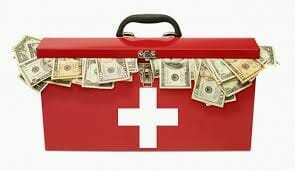If you are lucky enough to have paid down all of your debts and are moving towards financial independence, I want to say congratulations! So, what do you do now that you have no debts Are you done with your watching your finances? Nope! You still have more that you should do with your money, to help you become more financially stable and independent. The very next step once your debt is paid down will be a fully funded emergency fund.
Let’s get back to basics first. What exactly is an emergency fund? It is money that you have saved for an emergency. Some examples could include the furnace going out, your refrigerator needing repair, etc. Items that aren’t emergencies are a flat screen TV marked way down, new soccer cleats for your child or a vacation to Mexico. Those items are wants and you should save for them separately.
What my husband and I actually have done is established two savings accounts at our bank. One of them is for saving money for upcoming events or things we want — like property taxes, home owner’s fees, birthdays, holidays, etc. Our emergency fund is for our emergencies only. The reason we keep them separated is that for us, it is easier to keep track of what we have saved. Plus, when we need to spend money from savings, we know exactly how much money is available. For us, it is just simpler.
The biggest reason people need an emergency fund these days is in the case of job loss. It is taking Americans much longer to find new employment after downsizing. That requires more money to carry you through the rocky times. Prior to the recession, if you had 6 months saved as a single person or 6 months if you had a family to support, you were considered to be doing well. Now, it is recommended you have a minimum of 6 months as a single person and even as much as 9 – 12 months for a family. I know, that seems like a lot of money, and it will take time, but it is possible.
Once your debts are paid off, you now have ‘extra money’ in your paycheck. Well, not really. Once your debts are paid down, it is time to start paying yourself. You should take that money and start to save it. Even if it is only $500 a month, look at what you will have saved in 6 months time — $3,000! Sure, it might take you a year or two to get that money saved up – but it might also go more quickly than you think. Windfalls, bonuses, tax returns – these are all things you can use to contribute towards your savings to help you achieve your financial goal.
Just when you think your debt free journey is over, you will find that there is another one stepping in to take it’s place. It is not a race to the finish line. In the case of financial freedom, slow and steady always wins the race.
(I am not a financial advisor and the information listed within these Debt Challenge posts is not to be construed a financial advice. This is knowledge we gained through our own personal experiences and information as outlined in Dave Ramsey’s Financial Makeover — and is being shared as such. Participants are not required to follow any steps listed if they do not wish to do so. Financial concerns/issues should be addressed with a professional in order to receive advice and assistance.)
